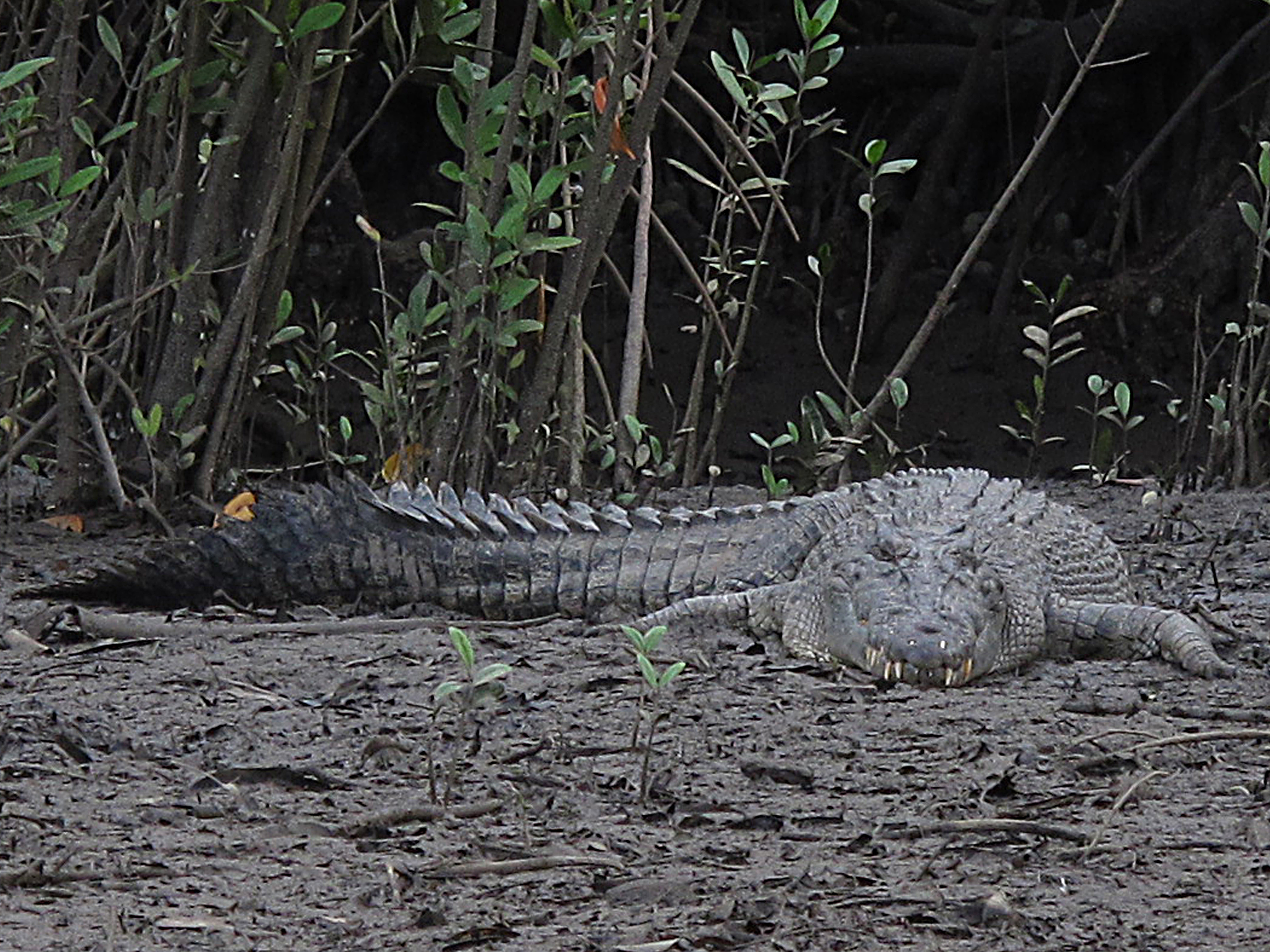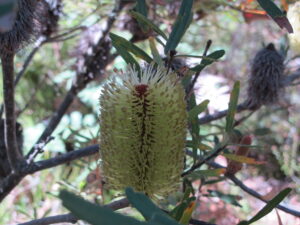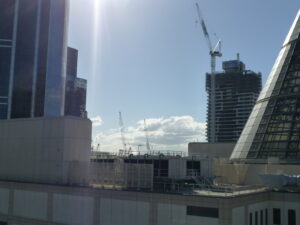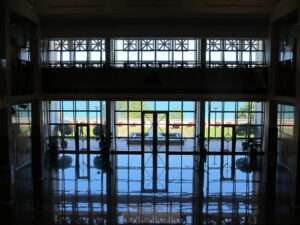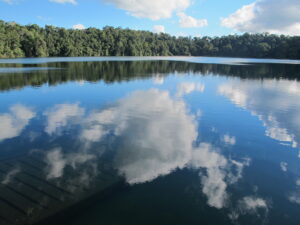In the 18th century the renowned Australian explorer, Captain James Cook, ran aground on the now equally renowned Great Barrier Reef. His ship was near a peninsula jutting from the coast of Queensland north of Cairns. After this difficulty and other problems, Cook named the point “Cape Tribulation because here begun all our troubles”.
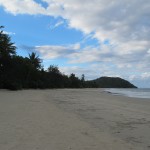
The shoreline of tropical Queensland still might look similar to what Cook saw while boating about. But much has changed on the land. Resorts have sprouted up and down the coast though fortunately prevented from encroaching visually on the beach. Farming, particularly hectares and hectares of sugar cane, have supplanted much of the remaining coastal rainforest.
But he would recognize the landscape of The Daintree, a rare preserve of dense ancient rainforests (according to Queensland, most of the world’s 19 primitive plant families are found around here). At Daintree National Park you can cruise along exotic mangrove swamps and rivers teeming with crocodiles, or walk among the wild diversity of mangrove trees, palms, figs and ferns – as well as along its unspoiled beaches. This area too was subject to some development over the years, but much of the rainforest stayed and has been restored under government protection.
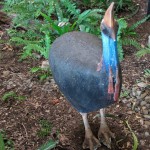
You run into few troubles taking Captain Cook Highway, State Route 44, for the two hours it takes to drive from Cairns up to Cape Tribulation. You must cross the Daintree River on a veteran cable ferry to explore the heart of the rainforest, though we encountered only a ten minute delay on our return crossing and light traffic. Then there are the well-marked and the less obvious speed bumps threatening the bottom of your car like a reef. Their apparent intent is to help avoid running into one of the cassowary, an endangered species of four foot tall birds with a mean disposition. We had to take their presence on faith, however, since we never saw one on the road or along the gullies they are supposed to frequent.
Otherwise, it’s an easygoing and pleasant drive to the Cape. Most real difficulties begin just afterwards, as a challenging dirt road takes you further up the coast to the northern tip of Queensland. You can tell how demanding – and enticing – that stretch is by counting all the fully provisioned Range Rovers heading up there.
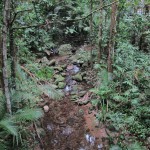
We had already spent a delightful half day at Mossman Gorge near the highway at the southern end of The Daintree, just above Port Douglas. The Australian government has turned this part of Daintree National Park, over to the Kuku Yalanji people, whose ancestors were the “traditional owners” of the area before European settlers. They operate it and staff it on their own, presumably with some government money to fund the fancy visitor centre and shuttle buses.
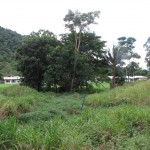
They also live and farm the land in a small village of contemporary homes between the gorge and the centre, as we discovered by walking two or three kilometres back from the circuit trail through the gorge.
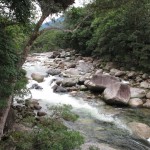
Though the tribespeople offer lengthy guided tours, we chose to take our time with the pleasant lush rainforest walk there, as well as on the track along the turbulent, boulder-strewn riverway. Several other visitors swam within the relatively calm but chilly pools of the lower portion of the river.
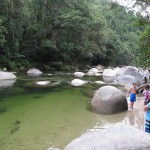
But the Daintree still called out to us. Besides, we find that the main reason people come to Queensland – the beaches – is only appealing for a while. After maybe a day or two, the idea of hanging out on a beach starts feeling like tribulation to us.
So, later in the week, we took a whole day to explore the rest of Daintree National Park. We skipped tourist magnets like the Daintree Discovery Centre. According to others, that’s a high-priced theme park version of the rainforest adorned in primary colors, and a very expensive package of pleasures you can find elsewhere in the park.
Instead, we savored The Daintree in three different ways:
Hiking the hillside rainforest
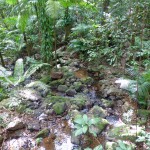
At the southern end of the park, a short while after the ferry, is a portion of rainforest called Jindalba, or Foot of the Mountain. We bypassed the shorter wooden walkway and hiked instead for an hour or so along a challenging stone-strewn, but well-marked trail.
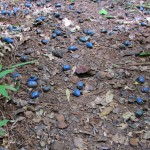
We followed the contours of the hills through tall fruit-bearing trees and ferns, a relatively dry terrain except for several small creeks trickling down the folds of the hills. When thirsty, we drank from the clear waters.
We saw no cassowaries, but we did see a nearly limitless supply of purple fruit from the eponymous Cassowary Plum, a favorite food of the bird, but toxic to people and most other animals. As the cassowary does not digest the seeds, it actually spreads them around the forest to create new trees.
Strolling the boardwalks in mangrove swamps
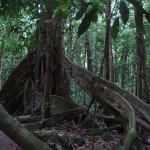
Near Cape Tribulation, we took several short walks, at Dubuji by the shore and at Mardja, where some of the most ancient types of plants thrive. The term mangrove designates not just one kind of tree, but includes a wide variety of those that thrive at the salty margins of ocean and land, here apparently numbering 26 different species. By necessity, you follow boardwalks constructed through the most interesting parts of these extraordinary low-lying mangrove swamps. One reason for the walkways is to protect the plant-life. The other is to protect the tourists – from snakes, leeches, crocs, stinging trees (don’t even ask), let alone sinking into the mud. That mud is richly alive stuff in itself: according to biologists, a teaspoon of it contains more than 10 million bacteria, among the highest concentrations in the world.
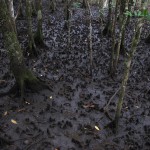
We’ve learned much about rainforests from other visits in Australia and New Zealand, and interpretive signs here coached us about different species and their botany. Yet it’s natural to be awed by the abundance alone, rather than the details and distinctions.
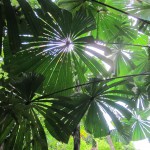
Still, two sections stood out for us. One was a dark, dank portion of mangrove forest at Mardja, where peg-like or snorkel-looking tree roots jut from the mud. Odd looking as they are, the roots supply the trees with oxygen, while also filtering the salt so the tree can use the water (among other techniques for coping). The dim light, as well as the fantastic shapes of the trees and their roots, created a suitably Grimm mood. The other was the grand, gracious canopy of broad-leaved umbrella-shaped palms all along the Dubuji walkway, ending at a scenic bay south of the Cape.
But again no cassowaries.
Cruising the river
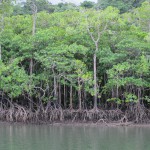
Walking the trails doesn’t give you a full picture of this area. You need to cruise some of the waterways as well. Besides, everyone who visits here wants to see crocodiles. So it’s not surprising that so many cruise boats operate in the upper and lower portions of the Daintree River, especially out of the touristy Discover Centre. We discovered a more down-to-swamp version with Cape Tribulation Wilderness Cruises on Cooper Creek. Ernie, our guide, has cruised these swamps for years and seems to know most of the crocodiles personally. His sardonic commentary on the swamp and croc culture was enough to enjoy, but he also delivered on what we came to see…
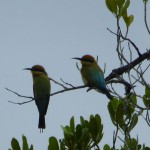
Thickets of mangroves standing above the water line with their stilt-like roots exposed. Birds, like the stealthy mangrove heron, the welcoming Welcome Swallows and the rainbow bee-eater with its two-pronged tail extension. Fish: two spooked fish suddenly flew in opposite directions for 15 meters or so along the surface, as if shot from a water cannon; later, a large school of mangrove jack passed alongside.
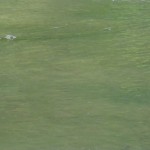
And, of course, crocodiles, hard to spot in the water since you only notice their eyes and snout above the surface, but easy for the crocodile hunter Ernie. The best sighting was a regular, a huge female estuarine crocodile (the kind generally found in salty waters).
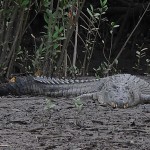
A ghostly green color, she sprawled on an exposed sandbar, warming herself sleepily as crocs often do, immobile, with that devilish grin of knife-like teeth. No others sunned on the banks in the cooler, cloudy day, but she was quite a sight in herself. The other interest was an equally large visitor near the river mouth, a male that at first lurked just at the surface across the water, but then stalled only 10 to 15 meters from where we disembarked. Unconcerned by him, at least on his surface, Ernie stood watchfully between the paying customers and the croc near the bank watching back.
Swimming?
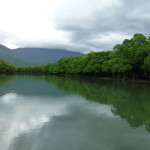
While at Daintree, we did not swim at the beach (or in the rivers, of course). During our cruise through the mangrove swamps, Ernie noted that the visiting croc we saw came from the ocean where estuarines may prowl close to the shoreline or slither up onto the beach. That was a surprise to us, as we had thought crocs only hung about riverways. “Swimming around here is how we sort out the intelligent people from the others,” he quipped.
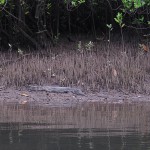
We understood what he meant when we saw bright yellow signs posted on most of the Daintree beaches we saw, warning of croc sightings (and seasonally the stinger jelly fish). But apparently, as Ernie knew, some people are as dumb as those in Yellowstone Park who march their children up to see buffalo, elk and even bears. Crocodiles often have better things to do than bother with people. But with wild animals you never know what will happen. As the government suggests: “If you see a crocodile, walk away. Do not feed it. Do not take a photo. Just leave.”
Perhaps sea-going crocodiles caused some of the problems that were a tribulation to Captain Cook before he left. They certainly did for his namesake, Captain Hook.
(Also, for more pictures from Australia, CLICK HERE to view the slideshow at the end of the Australia itinerary page.)
NOTE:
For an astonishing set of facts and insights into Daintree National Park, take a look at this manual for guides who tour visitors about: www.crocodileexpress.com/Daintree__Guides_Handbook.pdf.
Try not to show off with your guide though.


